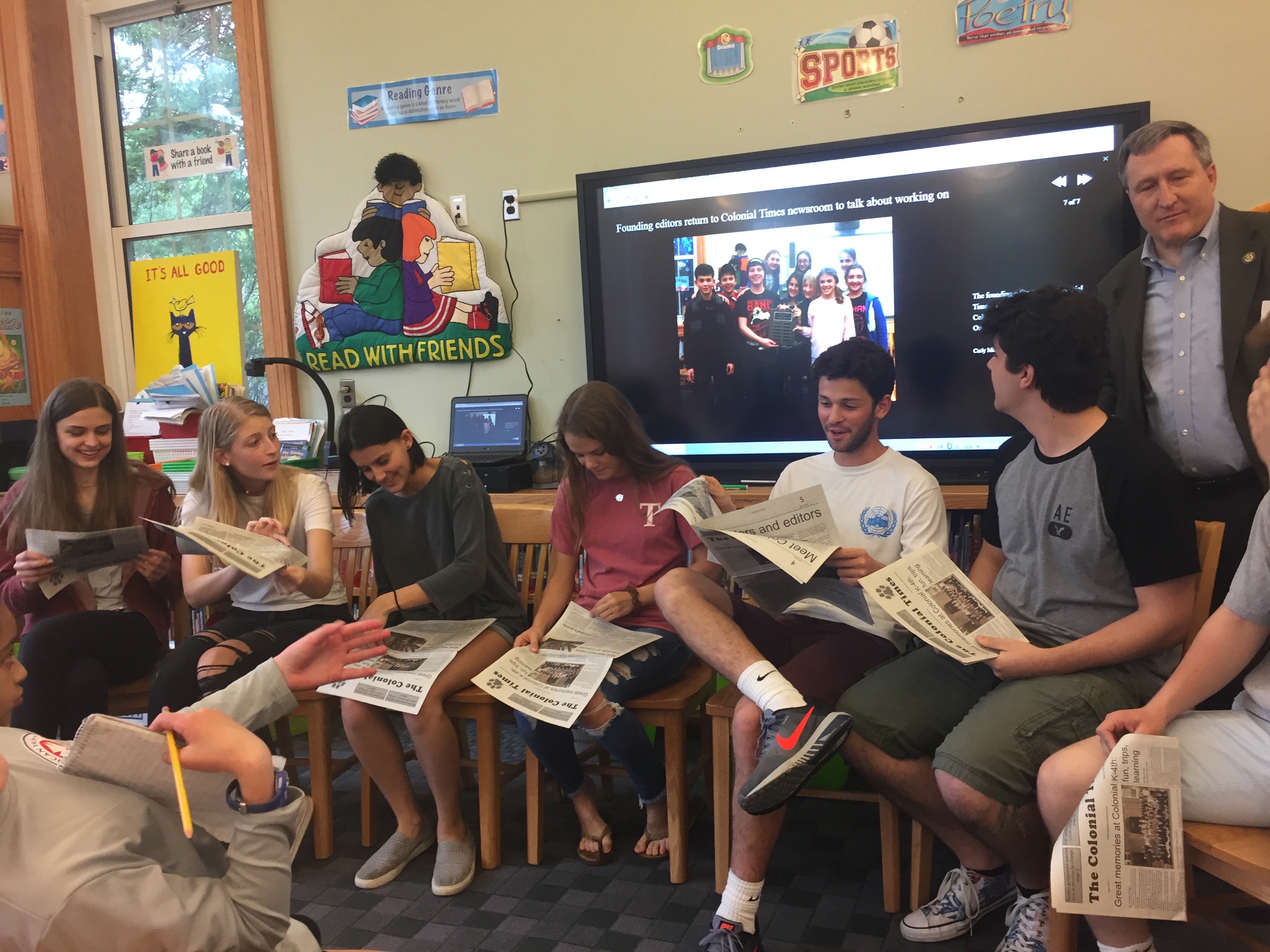On Monday, Rich Zahradnik stopped by the elementary school for a quick word with his editors. He found the fifth graders on the playground. Soon, he was surrounded by 10 fourth graders who really wanted to write for the Colonial Times, too.
“I’ve told people I couldn’t go back and work with adults,” said Zahradnik, a former journalist who worked at places including CNN and Bloomberg and is now a novelist. “Kids are a lot more fun to work with. They revel in it. They celebrate it. They want to be doing it.”
Zahradnik is also the adviser to the staff of the Pelham Examiner, a local news site formed by middle school and high school students in Pelham, New York, after the bi-weekly community paper folded. Many of those kids worked with Zahradnik in elementary school.
He didn’t have much of a plan for teaching kids journalism when he quit daily news and started writing novels. But Zahradnik didn’t bake brownies and wasn’t on any committees at his son’s school. So starting a newspaper seemed like one way he could help. Now, all four elementary schools in the district have their own online news sites.
Most of what works are things he’s learned along the way, including publishing online fast to maintain a young reporter’s enthusiasm. A lot of it still applies to grown-up journalists, too.

First, you gotta master the basics
Zahradnik took the four-paragraph lead from Bloomberg’s style guide, “The Bloomberg Way,” and boiled it way down. Instead of a four- or five-graph lead, his kids are often writing four- or five-graph stories.
So Zahradnik focused on teaching them to cut the nut graph — “the school picnic doesn’t need a nut graph” — and focus on the lead, the details and getting the how and the why into the second graph instead of cramming it into the first.
By the middle of fifth grade, most kids have mastered that concept and can write straight feature stories. One of his young stars, Francesca Di Cristofano, who’s now a high school senior and the Examiner’s managing editor, started writing anecdotal leads early in high school.
Kids can handle writing simple news stories, including when that news is not positive, he said. But it starts with mastering the basics.

Reporter’s notebooks are still magic
In an early meeting with his first group of young journalists, Zahradnik brought in a pile of reporter’s notebooks. He didn’t expect a generation raised with electronics to get too excited.
“Their eyes went big as quarters when they saw these notebooks,” he said.
By the second year, “Print newspapers are dying and I‘ve got 10-year-olds that want to do a print newspaper.”
So Zahradnik found a printer that publishes school newspapers with a simple web-based design that the kids could build themselves. As journalism struggles to find new business models and remain relevant and trusted, he’s got kids excited about paper.
“They’re attracted to some of the things in journalism that are going away fastest,” he said, “like print, like taking notes, like working from facts.”

Great reporters don’t necessarily make great editors
“I think the hardest thing to teach that I haven’t had to teach before is leadership,” Zahradnik said. “I don’t think leadership is in the AP Stylebook.”
This is one of his next big challenges. For the Examiner to be self-sustaining, it’s going to need an independent staff that manages itself. But as many working journalists know, the skills that make great journalists aren’t always the same skills that make great leaders.
School just started a few weeks ago, and Zahradnik is giving the Examiner’s staff time to figure out how to balance their studies, extracurriculars and community journalism.
Regardless of what they become when they grow up, he hopes that working with the news is teaching those students a form of media literacy that they need right now — what’s real and how and where to find it.
I thought we’d start a new month’s topic on collaborations, but I’m instead going to try untethering from month-long topics and play with this space a little to see what works and where we should go next. Please let me know what you think.
In the meantime, some quick reading:
-
Two states now have cross-newsroom collaborations covering state government.
-
An INN survey reports that there are 2,200 journalists in 180 nonprofit newsrooms.
-
Thirty-seven staffers were laid off last week at the Oklahoman after it was sold to GateHouse.
-
Solutions Journalism Network is accepting grant proposals for midterm election coverage.
-
Are you going to LION’s conference in Chicago next week? Say hi if you are; I’ll be there!
-
And you still have time to sign up for the last webinar from me in this series on Lessons from Local.
See you next week!







